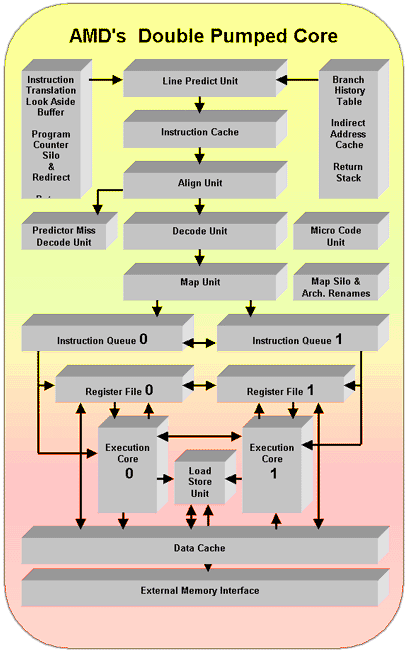Wat eerder al openlijk door AMD werd toegegeven, lijkt nu ook bevestigd te worden in een aantal patenten die AMD recentelijk heeft verkregen. Volgens Hans de Vries van Chip-Architect.com geven een drietal nieuwe patenten een indicatie dat de Sledgehammer mogelijk de beschikking heeft over twee processor cores. De patenten beschrijven een architectuur met twee pipelines, die gebruik maken van dezelfde instructie cache en instructie decoders. De pipelines communiceren met elkaar via de load/store unit. Omdat de frequentie van de twee pipelines met een halve kloktik verschilt, kan een hapje data in een halve kloktik naar de andere pipeline fietsen.
Het is nog onduidelijk op welke wijze de twee cores benut worden. IBM heeft aangekondigd dat zij bij hun Power4 processor gebruik gaan maken van CMP (Chip Multi-Processing), wat feitelijk niet meer is dan SMP op een enkele chip. Het besturingssysteem ziet geen verschil met een normaal dual-processor systeem. Compaq heeft gekozen voor een meer revolutionaire benadering, waarbij een enkele processor op chip niveau meerdere threads (OS level) kan verwerken. Dit zogenaamde SMT ofwel 'Simultaneous Multi-Threading' zal gebruikt worden in de Alpha 21464 en kan in theorie een veel hogere performance bereiken dan SMP of CMT:
Another approach which looks very promising is that of Compaqs EV8 or 21464 Simultaneous Multi Threading processor. It seems that this processor will double the processing resources of its current 21264. Revolutionary is the ability to do 4-way multithreading. It can run up to 4 threads at the same time with four program counters. Instructions from various thread travel down the pipeline and divide the processor resources. Alternatively a single thread may have the huge amount of processing resources for itself alone and run far faster than on any other uni-processor. That is: if and only if it's code contains a sufficient amount of ILP (Instruction Level Parallelism) That is often not the case and it would normally be not economical to put so much hardware into a uni-processor. SMT (Simultaneous Multi Threading) however provides the best of both worlds. It provides multiprocessing whereby the processors execution units are used with maximum efficiency but it can also operate as a shamelessly huge uni-processor.AMD's new micro-architecture seems to fit somewhere between these two approaches. Exactly what it can and can't do will probably become clearer when more and more patents arrive.
 |
De technische details vind je in het artikel van Hans de Vries (hij was trouwens ook degene die verantwoordelijk was voor dat prachtig .PDFje met een technische analyse van de Mustang en Pentium 4 performance).

